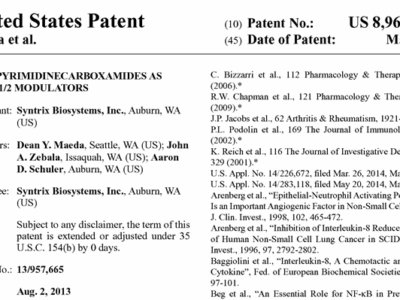
Large patient populations treated with dangerous Schedule II opioids are expected to benefit from Omnitram, a safer alternative without metabolic liabilities and related “black box” safety warnings.
While there are 25 million patients sufferng from daily pain in America, there was an estimated 20,500 prescription opioid deaths due to overdose with the dangerous Schedule II opioids. Treating pain safely remains a difficult clinical problem and unmet need. Desmetramadol (Omnitram) is a new investigational pain medication being developed as the first safer Schedule IV opioid without metabolic liabilities and related “black box” safety warnings. Many of the 170 million Schedule II prescriptions in the U.S. could potentially be replaced by a safer Schedule IV analgesic.
Schedule II codeine and Schedule IV tramadol have metabolic liabilities and related “black box” safety warnings. In the next phase of study of Omnitram’s treatment of acute pain, Syntrix has dosed the first subject in a trial to establish the absence of such metabolic liabilities, by demonstrating Omnitram’s effectiveness in patients unable to metabolize tramadol and in whom tramadol lacks efficacy.
Omnitram is predicted to provide the same net pharmacology as tramadol, but, in contrast to tramadol, it does not require the activity of the liver and intestinal enzyme, cytochrome P450 2D6 (CYP2D6) for its effectiveness.
Multiple antidepressants, commonly prescribed to chronic pain patients, render patients deficient in the CYP2D6 activity needed to metabolize tramadol. Genetic factors are also associated with CYP2D6 deficiency. For any CYP2D6-compromised population, tramadol is ineffective.
In the double-blind, randomized cross-over study now underway, each subject undergoes a three-segment trial —first receiving Omnitram plus the antidepressant paxil, then a placebo plus paxil, and then tramadol plus paxil — before exposure to temperature challenges to determine pain sensitivity. While the study will directly demonstrate Omnitram’s ability to provide pain relief in patients phenoconverted to CYP2D6 deficiency by taking an antidepressant, the trial will also have implications for patients who are CYP2D6 compromised for genetic reasons.
Stuart Kahn, MD, Syntrix Medical Director, stated, “Due to the metabolic limitations of tramadol, large numbers of pain patients have not been receiving adequate relief on tramadol. Often, they find relief only from opiates that provide dangerously high levels of morphine equivalent dosages. The side effects and risks those patients face include dependency and death. All of these patients will finally have access to the benefits of tramadol though Omnitram.”
Tramadol’s safety as a pain medication has made it the second-most prescribed analgesic in the United States with over 40 million prescriptions written a year.
John Zebala, MD, PhD, President and CEO said, “With Omnitram broadly increasing the utility of tramadol and enhancing its safety, we expect to further accelerate the shift away from Schedule II opiates.”
Omnitram was developed by Syntrix with extensive prior grant support from the National Institute on Drug Abuse (NIDA) of the National Institutes of Health (NIH).
A previous double-blind, cross-over Phase I study examined Omnitram’s safety, pharmacokinetic properties (absorption, distribution and excretion), and analgesic activity.
ABOUT SYNTRIX: Syntrix is a pharmaceutical company committed to discovering and delivering innovative therapies by doing things differently. We innovate in discovery and clinical trials, engineer risk prospectively, integrate IP strategy creatively, and leverage non-dilutive capital to solve the most difficult clinical problems. Convergent Science & Strategy. Breakthrough Medicines.
DISCLOSURE NOTICE: This release contains forward-looking information that are based on company management’s current beliefs and expectations and are subject to currently unknown information, risks and circumstances and actual results may vary from what is being currently projected. In addition, from time to time, Syntrix or its representatives have made or may make forward-looking statements, orally or in writing. Forward-looking statements can be identified by the use of forward-looking words such as “believe,” “expect,” “intend,” “plan,” “may,” “should”, “could” or “anticipate” or their negatives or other variations of these words or other comparable words or by the fact that these statements do not relate strictly to historical or current matters. Forward-looking statements relate to anticipated or expected events, activities, trends or results as of the date they are made. Because forward-looking statements relate to matters that have not yet occurred, these statements are inherently subject to risks and uncertainties that could cause Syntrix’s actual results to differ materially from any future results expressed or implied by the forward-looking statements. Many factors could cause Syntrix’s actual activities or results to differ materially from the activities and results anticipated in such forward-looking statements. Syntrix does not undertake any obligation to publicly update these forward-looking statements, whether as a result of new information, future events or otherwise.
Media Contact: Aaron Schuler, PhD, 253-833-8009, x21



